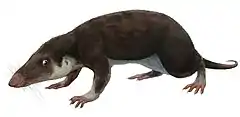Tritylodon
Tritylodon (from the Greek for "three-cusped tooth") is an extinct genus of tritylodonts, one of the most advanced group of cynodont therapsids. They lived in the Early Jurassic and possibly Late Triassic periods along with dinosaurs. They also shared many characteristics with mammals, and were once considered mammals because of overall skeleton construction. That was changed due to them retaining the vestigial amniote jawbones and a different skull structure. Tritylodons are now regarded as non-mammalian synapsids.[1]
| Tritylodon Temporal range: Early Jurassic | |
|---|---|
 | |
| Tritylodon longaevus | |
| Scientific classification | |
| Domain: | Eukaryota |
| Kingdom: | Animalia |
| Phylum: | Chordata |
| Clade: | Synapsida |
| Clade: | Therapsida |
| Clade: | Cynodontia |
| Family: | †Tritylodontidae |
| Genus: | †Tritylodon Owen, 1884 |
| Type species | |
| Tritylodon longaevus Owen, 1884 | |
| Species | |
| |
Characteristics
If a living Tritylodon were to be seen today, it would look a lot like a large rodent. They were about 30 centimetres (12 in) long but there is no certainty about the exact weight. Their method of chewing food, a grinding motion with the bottom teeth sliding against the top teeth, resembled that of rodents as well. The bottom teeth were much like a set of cusps and the top teeth were a set of matching grooves that matched perfectly allowing this motion. There were large incisors at the very front of their mouth separated by a gap from the rest of the teeth. The incisors would stick out and remain slightly visible when the mouth was closed. The legs were directly beneath the body like mammals, unlike the earlier therapsids with sprawling limbs.
These animals were burrowers; the structure of the shoulder, front limbs, and large front incisors show this. They used their incisors to help dig and unearth buried plants. The way they ate and the shape of their teeth demonstrate that Tritylodons were probably primarily herbivorous (though some tritylodontids show evidence of more omnivorous diets, and modern analogues like rodents tend to be more omnivorous than their dentitions lead on[2]). Any of the Tritylodonts including Tritylodon were warm-blooded or endothermic. Like most non-placental mammalimorphs, it had epipubic bones, aiding in its erect gait but preventing the expansion of the abdomen, making it unable to go through prolonged pregnancy and instead give birth to larval young like modern marsupials and monotremes.[3]
Habitat
The Tritylodons' habitat was limited to the forests of South Africa, with other fossils found in the Hanson Formation of Antarctica. When the species originated, about 200 million years ago, the African area was drier and hotter. But for most of their existence the climate was tropical and wetter.
Fossils
The Tritylodon fossils in South Africa are found concentrated mainly in an area about 11,000 km² (4,250 mi²). They have been found in floodplain deposits of the Lower Jurassic Elliot Formation (upper Karoo Supergroup).[4] In this area there have been so many findings it has been named the Tritylodon Acme Zone.[5] The fossil findings have all been in the Free State of South Africa.[5]
The genus Tritylodon of the Tritylodonts is restricted to the South African forms: Tritylodon longaevus and Tritylodon maximus.[1] It is suggested that T. maximus is either a large T. longeavus or a closely related species. If it is a closely related species it could possibly be ecological succession since the larger T. maximus fossils have been dated in the Sinemurian–Pliensbachian mainly less than 190 million years ago and the T. longaevus in the Hettangian–Sinemurian mainly more than 190 million years ago. With the fossil findings of each species overlapping in Sinemurian stage, the fossils show two differences, T. maximus being larger and having nine upper postcanines (neither species had canine teeth) instead of the seven teeth like T. longeavus. All other structures of the two Tritylodon species were the same.[6]
Below is a cladogram from Ruta, Botha-Brink, Mitchell and Benton (2013) showing one hypothesis of cynodont relationships:[7]
| Cynodontia |
| ||||||||||||||||||||||||||||||||||||||||||||||||||||||||||||
| → †Cynognathia |
| ||||||||||||||||||||||||||||||||||||||||||||||||||||||||||||||||||||||||||||||||||||||||||||||||||||||||||||||||||||||||||||||||||||||||||||||||
| → Probainognathia |
| |||||||||||||||||||||||||||||||||||||||||||||||||||||||||||||||||||||||||||||||||||||||||||||||||||||||||||||||||||||
References
- "Cynodontia: Tritylodontidae". Palaeos. Archived from the original on December 21, 2010.
- Hu, Yaoming; Meng, Jin; Clark, James M. (2009). "A New Tritylodontid from the Upper Jurassic of Xinjiang, China". Acta Palaeontologica Polonica. 54 (3): 385–391. doi:10.4202/app.2008.0053.
- Reily, Stephen; White, Thomas (January 2003). "Hypaxial Motor Patterns and the Function of Epipubic Bones in Primitive Mammals". Science. 299 (5605): 400–2. doi:10.1126/science.1074905. PMID 12532019.
- Bordy, Emese M. (2008). "Enigmatic trace fossils from the Aeolian Lower Jurassic Clarens Formation, Southern Africa" (PDF). Palaeontologia Electronica. 11 (3).
- Smith, R.; Kitching, J. (1997). "Sedimentology and vertebrate taphonomy of the Tritylodon Acme Zone: A reworked palaeosol in the Lower Jurassic Elliot Formation, Karoo Supergroup, South Africa". Palaeogeography, Palaeoclimatology, Palaeoecology. 131 (1–2): 29–50. doi:10.1016/S0031-0182(96)00143-5.
- http://home.arcor.de/ktdykes/jtherap.htm#tritylodon Archived 2010-04-23 at the Wayback Machine
- Ruta, M.; Botha-Brink, J.; Mitchell, S. A.; Benton, M. J. (2013). "The radiation of cynodonts and the ground plan of mammalian morphological diversity". Proceedings of the Royal Society B: Biological Sciences. 280 (1769): 20131865. doi:10.1098/rspb.2013.1865. PMC 3768321. PMID 23986112.
External links
- "Tritylodon". fossils.valdosta.edu. Retrieved 2014-01-25.
- "tritylodont (fossil reptile genus) -- Encyclopedia Britannica". britannica.com. Retrieved 2014-01-25.
- "dinosaurs_A-D". Archived from the original on 2007-10-27. Retrieved 2014-01-25.
- Clack, J. A. (2002). "An early tetrapod from 'Romer's Gap'". Nature. 418 (6893): 72–6. doi:10.1038/nature00824. PMID 12097908.
- https://archive.today/20130204222846/http://tritylodontidae.totallyexplained.com/
- "Jurassic Period - ZoomDinosaurs.com". enchantedlearning.com. Retrieved 2014-01-25.





